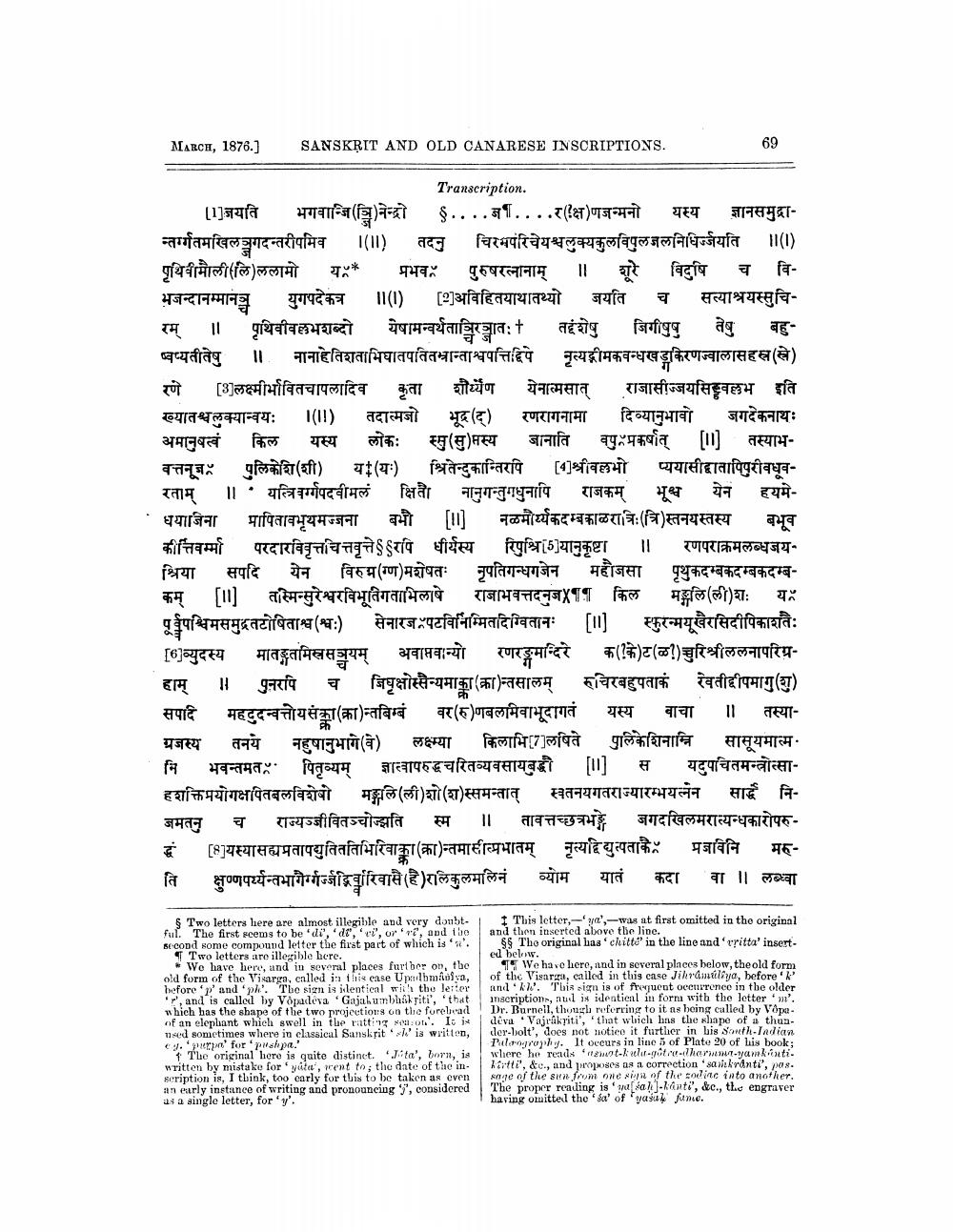________________
MARCH, 1876.]
हाम् सपदि
SANSKRIT AND OLD CANARESE INSCRIPTIONS.
Transcription.
....... ( क्ष ) णजन्मनो यस्य ज्ञानसमुद्रा
चिरमरिचेयश्धलुक्यकुलविपुललनिधिज्यति
11 (1)
रम्
[1]जयति भगवान् (जिनेन्द्री न्तर्गतमखिल गदन्तरीयमिच 1(11) तदनु पृथिवीमल (लामो य* प्रभव पुरुषरत्नानाम् ॥ शूरे विदुषि च विभवन्दानम्मानव युगपदेक 11(1) [2] अविहितयाथातथ्यो जयति च सत्याश्रयस्तुचिपृथिवीवल्लभशब्दो येषामन्वर्थाचा + तईशेषु जिगीषुषु तेषु बहुष्वप्यतीतेषु II. नानाहेतिशताभिघातयवितवान्तापयन्तिदिये नृत्यङ्गीमकनन्धरज्यासह (खे) रणे [3] लक्ष्मीर्भावितचापलादिव कृता शौर्येण येनात्मसात् राजासीज्जयसिङ्घवल्लभ इति ख्यातश्चलुक्यान्वयः 1(11) तदात्मजो भूद्र (द्) रणरागनामा दिव्यानुभावी जगदेकनाथः अमानुप किल यस्य लोक: स्सु (सु) तस्य जानाति [11] तस्याभपुलकेशि (शी) ब: (य) श्रितेन्दुकान्तिरपि [4] श्रीवल्लभो प्ययासीद्वातापिपुरीवधूव॥विमलं क्षिती नानुगन्तुमधुनापि राजकम् भूश्व येन हयमेमापितावभूयमज्जना बभी 回 नळमौर्य कदम्बकाळरात्रिः (त्रि) स्तनयस्तस्य बभूव कीर्तिम परदारविवृत्तचितवृत्तेरपि चीर्यस्य रिपुश्रि [5] यानुकृष्टा 11 रणपराक्रमलब्धजयश्रिया सपदि येन विरुम (ग) मशेषतः नृपतिगन्धमन महौजसा पृथुकदम्बकदम्बकदम्बकम् [11] तस्मिन्सुरेश्वरनिभूविगताभिलाषे राजाभवत्तदनुज X किल मङ्गल (ली) श य पूर्वपश्चिमसमुद्रतटीपिताश्व (:) सेनारज पटविनिम्मितदिग्वितान [1] स्फुरन्मयूखैरसिदीपिकाति [6] व्युदस्य मातङ्गतमिस्रसज्ञयम् अवाप्तवान्यो रणरङ्गमन्दिरे क(])] (])रिश्री ललनापरिय" पुनरपि च जिपक्षोसेन्यमाका (का) तसालम् रुचिरबहुपताकं रेवतीमा (शु) महदुदन्वत्तोयसंक्का(क्रा)न्तबिम्बं महदुदन्वत्तीय संका (का) [तविम्बं मर (रु) गवलमियाभूदागतं
वत्तनूज
रताम्
धयाजिना
यस्य बाचा 11 तस्या
11
69
मि
ग्रजस्य तनये नहुषानुभागे (३) लक्ष्म्या किलाभि[7] लषिते पुलिकेशिनानि सासूयमान्य भवन्तमतः पितृव्यम् शयापरुद्धचरितव्यवसायी ["] स यदुपचितमन्त्रोसा हशक्तिप्रयोगक्षपितबलविशेषो मङ्गल (ली) शो (श) स्समन्तात् स्वतनयगतराज्यारम्भयलेन सार्द्ध निजमतनु च राज्यजीवितञ्चोन्झति स्म 11 सावतच्छत्रभङ्गे जगदखिलमरात्यन्धकारोपरु[8] यस्यासप्रतापयुतिततिभिरियाका (कान्तमा सयभातम् नृत्यहि युत्यताक मजविनि क्षुष्णपर्य्यन्तभागेरियाले ( है ) रलिकुलमि व्योम
इं
मरु
fir
यातं कदा वा ॥ लब्ध्वा
§ Two letters here are almost illegible and very doubtful. The first seems to be 'di', 'dt', 'i' or '+'', and the second some compound letter the first part of which is ". Two letters are illegible here.
We have here, and in several places further on, the old form of the Visarga called in this case Upalhmaolya, before 'p' and 'ph'. The sign is identical with the letter '', and is called by Vápadeva Gajakumbhakriti', 'that which has the shape of the two projections on the forehead of an elephant which swell in the ratting season. It is used sometimes where in classical Sanskrit is written, eg. purpo' for 'pushpa."
+ The original here is quite distinct. 'Jita', born, is written by mistake for 'yata', went to the date of the inscription is, I think, too early for this to be taken as even an early instance of writing and pronouncing 5, considered as a single letter, for 'y'.
This letter,-ya',-was at first omitted in the original and then inserted above the line.
55 The original has cliitte' in the line and 'rritta' inserted below.
We have here, and in several places below, the old form of the Visarga, called in this case Jihrámúliya, before 'k' and k. This sign is of frequent occurrence in the older anscriptions, nud is identienl in forn with the letter 'm". Dr. Burnell, though referring to it as being called by Vopa deva Vajrakriti', 'that which has the shape of a thaader-bolt', does not notice it further in his South Indian Palaography. It occurs in line 5 of Plate 20 of his book; where he reads nemot-kala-gôtra-harmma-yamkintikartte, &c, and proposes as a correction 'savikranti, pas sage of the sun from one sign of the zodine into another. The proper reading is 'ma[takj-kanti', &c. the engraver having omitted the ' sa' of 'yasuk funce.




